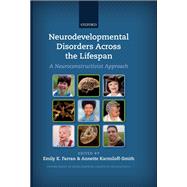
Note: Supplemental materials are not guaranteed with Rental or Used book purchases.
Purchase Benefits
What is included with this book?
| List of Contributors | p. xi |
| Introduction: Williams syndrome: A model for the neuroconstructivist approach | p. 1 |
| Cognition, Brain, Genes | |
| Cognition: The developmental trajectory approach | p. 13 |
| Brain: The neuroconstructivist approach | p. 37 |
| Genes: The gene expression approach | p. 59 |
| Clinical and Practical Outcomes | |
| Clinical profile: Diagnosis and prognosis | p. 85 |
| Adult outcomes and integration into society | p. 103 |
| Domain-General Processes | |
| Attention | p. 119 |
| Sleep-related learning | p. 135 |
| Memory | p. 149 |
| Executive function and motor planning | p. 165 |
| Domain-Specific Processes | |
| Verbal Domain | |
| Precursors to language and early language | p. 187 |
| Later language | p. 205 |
| Visual Domain | |
| Visual perception and visuospatial cognition | p. 225 |
| Spatial cognition, visuomotor action and attention | p. 247 |
| Social Domain | |
| Face processing and social, interaction | p. 265 |
| Mental state understanding and social interaction | p. 279 |
| Numeracy and Literacy | |
| Numeracy | p. 299 |
| Literacy | p. 313 |
| The Neuroconstructivist Approach to Domain-General and Domain-Specific Processes | |
| Integrating domain-general and domain-specific developmental processes: Cross-syndrome, cross-domain dynamics | p. 339 |
| Conclusion: Future theoretical and empirical directions within a neuroconstructivist framework | p. 363 |
| Author Index | p. 373 |
| Subject Index | p. 383 |
| Table of Contents provided by Ingram. All Rights Reserved. |
The New copy of this book will include any supplemental materials advertised. Please check the title of the book to determine if it should include any access cards, study guides, lab manuals, CDs, etc.
The Used, Rental and eBook copies of this book are not guaranteed to include any supplemental materials. Typically, only the book itself is included. This is true even if the title states it includes any access cards, study guides, lab manuals, CDs, etc.